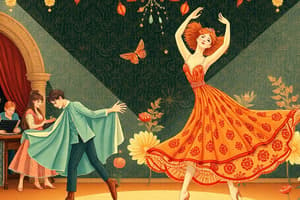Podcast
Questions and Answers
Who scored a big hit with her first release?
Who scored a big hit with her first release?
Ethel Waters
What genres did Ethel Waters frequently perform?
What genres did Ethel Waters frequently perform?
blues, jazz, and gospel
What was Ethel Waters the second African American to be nominated for?
What was Ethel Waters the second African American to be nominated for?
an Academy Award
Who was recognized as one of the originators of early jazz?
Who was recognized as one of the originators of early jazz?
What instrument did Lorenzo Tio Jr. master?
What instrument did Lorenzo Tio Jr. master?
Which African American musician is regarded as a key figure in the development of New Orleans style ragtime music?
Which African American musician is regarded as a key figure in the development of New Orleans style ragtime music?
What characterized Sidney Bechet's playing style?
What characterized Sidney Bechet's playing style?
What was Jelly Roll Morton recognized as in the early jazz genre?
What was Jelly Roll Morton recognized as in the early jazz genre?
What was the Original Dixie Land Jazz Band known for?
What was the Original Dixie Land Jazz Band known for?
Who was a strict bandleader that recognized Louis Armstrong's improvisational talent?
Who was a strict bandleader that recognized Louis Armstrong's improvisational talent?
Who was Louis Armstrong's mentor?
Who was Louis Armstrong's mentor?
What is James P. Johnson known for in jazz music?
What is James P. Johnson known for in jazz music?
Who co-wrote the Broadway musical Shuffle Along?
Who co-wrote the Broadway musical Shuffle Along?
What contribution did Earl 'Fatha' Hines make to jazz piano?
What contribution did Earl 'Fatha' Hines make to jazz piano?
What is Art Tatum widely acknowledged as?
What is Art Tatum widely acknowledged as?
What distinguishing feature is associated with Louis Armstrong's performances?
What distinguishing feature is associated with Louis Armstrong's performances?
What is a melody?
What is a melody?
What does harmony refer to in music?
What does harmony refer to in music?
What is rhythm in music?
What is rhythm in music?
Syncopation involves rhythms that are expected and predictable.
Syncopation involves rhythms that are expected and predictable.
Which of the following genres is characterized by a lively rhythm suitable for dancing?
Which of the following genres is characterized by a lively rhythm suitable for dancing?
Who were the Fisk Jubilee Singers?
Who were the Fisk Jubilee Singers?
Who is Scott Joplin?
Who is Scott Joplin?
What was James Reese Europe's contribution to music?
What was James Reese Europe's contribution to music?
What is improvisation in music?
What is improvisation in music?
What describes a call and response pattern in music?
What describes a call and response pattern in music?
What is the Theater Owner's Booking Association (TOBA)?
What is the Theater Owner's Booking Association (TOBA)?
Who is W.C. Handy?
Who is W.C. Handy?
What is the Great Migration?
What is the Great Migration?
What type of entertainment was Vaudeville?
What type of entertainment was Vaudeville?
What is Tin Pan Alley known for?
What is Tin Pan Alley known for?
Flashcards are hidden until you start studying
Study Notes
Key Jazz Terms and Concepts
- Melody: A sequence of single notes that creates a musically satisfying tune.
- Harmony: The combination of musical notes played simultaneously to form chords and progressions that sound pleasing.
- Rhythm: The arrangement of musical sounds based on duration and periodic stress.
- Syncopation: An unexpected rhythm that disrupts the regular flow, emphasizing weaker beats.
- Swing: A lively jazz style often performed by big bands, suitable for dancing, popularized by artists like Duke Ellington and Benny Goodman.
- Form: The structure of music composed of repetition and variation, leading to a musical phrase with a definitive rhythm and duration.
Influential Groups and Figures
- Fisk Jubilee Singers: An African American a cappella group known for singing spirituals and other songs.
- Scott Joplin: Renowned as the "King of Ragtime," he wrote significant ragtime compositions, including the influential "Maple Leaf Rag."
- James Reese Europe: A key figure in New York's African-American music scene and a pioneer in early jazz.
Jazz Techniques and Elements
- Improvisation: Spontaneous musical creation that combines performance, emotion, and technique, responding to fellow musicians.
- Motives and Phrases: A motif is a short recurring musical idea; phrases are sections of a composition often comprising four or eight measures.
- Texture: The manner in which different musical materials are combined, impacting the overall sound quality of a piece.
Historical Context and Cultural Elements
- Minstrelsy: An entertainment form involving comic skits and music performed often by white people in blackface.
- Congo Square: A gathering place in New Orleans vital for African American music history, where enslaved Africans would gather to sing and dance.
- Work Songs: Music specifically tied to labor, often sung to coordinate work or express a narrative.
Genres and Styles
- Brass and String Bands: Brass bands consist of brass instruments and percussion, while string bands focus on string instruments, influencing jazz and country music.
- Call and Response: A musical structure featuring alternating phrases, reflecting communication patterns found in many musical traditions.
- Dixieland: An early jazz style from New Orleans characterized by collective improvisation and rhythms, spreading to Chicago and New York.
Prohibition and Migration
- Prohibition (1919): A nationwide ban on alcohol that spurred the growth of speakeasies and underground music scenes.
- The Great Migration: The movement of 6 million African Americans from the rural South to urban areas seeking work and equality.
Notable Artists
- W.C. Handy: Known as the "Father of the Blues," he helped shape and nationalize the blues genre.
- Mamie Smith: First African American artist to make vocal blues recordings in 1920, establishing a significant legacy in the genre.
- Bessie Smith: The most popular female blues singer of her time, impacting later jazz vocalists with her powerful voice.
- Ethel Waters: A versatile performer known for roles in jazz, blues, and gospel, and an early nominee for Academy and Emmy Awards.
Influential Locations
- Storyville: A designated red-light district in New Orleans (1897-1917) that became a hub for jazz and blues development.
- Tin Pan Alley: The center of music publishing in New York City, shaping popular music in the late 19th and early 20th centuries.
Additional Terms
- Rent Parties: Social gatherings in Harlem where musicians played to raise money for rent, fostering jazz and blues progression.
- Cutting Contests: Musical battles among stride piano players that showcased improvisational skills.
- Collective Improvisation: A hallmark of early jazz, where multiple musicians improvisationally interact simultaneously.### Buddy Bolden
- Pioneered an innovative fusion of ragtime, black sacred music, marching-band music, and rural blues.
- Rearranged New Orleans dance bands by incorporating string instruments as the rhythm section.
- Notable for a loud, powerful "wide open" playing style on the cornet.
Sidney Bechet
- Renowned American jazz saxophonist and clarinetist, known for his forceful delivery and distinct wide vibrato.
- Important early jazz soloist, recorded before Louis Armstrong and collaborated in duets.
- Achieved wide acclaim in the late 1940s despite a turbulent career.
"Jelly Roll" Morton and Red Hot Peppers
- American ragtime and early jazz pianist and bandleader, considered a pivotal figure in early jazz.
- First jazz arranger and composer of notable tunes like "Jelly Roll Blues" and "King Porter Stomp".
- Red Hot Peppers was his recording band from 1926-1930, featuring top New Orleans musicians.
- Their recordings set a high standard for small group jazz with a balance of ensemble and solo play.
Original Dixieland Jazz Band (ODJB)
- First jazz band to make recordings commercially in early 1917, claimed authorship of classics like "Tiger Rag".
- The band consisted of five musicians from the diverse Papa Jack Laine bands, playing various events in New Orleans.
- Billed itself as the "Creators of Jazz", significantly influencing the genre's recognition.
Fate Marable
- Jazz pianist and bandleader known for a strict yet encouraging leadership style.
- Emphasized musical versatility and discipline in his bands, notably allowing improvisation from Louis Armstrong.
Joe "King" Oliver
- Influential American jazz cornet player and bandleader, known for pioneering mute usage in jazz.
- Composed many lasting tunes, including "Dippermouth Blues" and "Doctor Jazz".
- Mentor to Louis Armstrong, credited with significant impact on the evolution of jazz.
Louis Armstrong
- Iconic jazz trumpeter and singer, instrumental in shifting focus from collective improvisation to solo performance.
- Known for his gravelly voice and innovative scat singing.
- Widely recognized as a bridging figure between jazz and popular music, breaking racial barriers in America.
Bix Beiderbecke
- Significant jazz cornetist and pianist of the 1920s, known for his purity of tone and improvisational skills.
- Helped develop the jazz ballad style; blended classical influences with jazz in compositions like "In a Mist".
- Part of notable ensembles, including the Paul Whiteman Orchestra, and recorded influential tracks in 1927.
Austin High Gang
- Group of young white musicians from Chicago who significantly contributed to the Chicago jazz style in the 1920s.
- Members included notable figures such as Jimmy McPartland (cornet) and Bud Freeman (tenor saxophone).
James P. Johnson
- American jazz pianist and composer, a key figure in the stride piano style.
- Composed the famous "Charleston", linking ragtime with jazz, influencing numerous pianists.
- Recognized as an overlooked yet significant contributor to jazz piano and American musical theatre.
Eubie Blake
- Composer, lyricist, and pianist known for his influence on ragtime and popular music.
- Co-wrote "Shuffle Along," a groundbreaking Broadway musical for African Americans.
- His works included hits like "Charleston Rag" and were featured in the musical Eubie! in 1978.
Thomas "Fats" Waller
- Influential jazz pianist and entertainer, known for his contributions to the Harlem stride style.
- Composed popular pieces like "Ain't Misbehavin'" and "Honeysuckle Rose".
Earl "Fatha" Hines
- Pivotal figure in jazz piano development, influencing modern harmony and jazz styles.
- Praised by contemporaries like Dizzy Gillespie and Count Basie for transforming jazz piano playing.
Art Tatum
- Acclaimed as a virtuoso and possibly the greatest jazz pianist ever, known for his technical proficiency.
- His complex improvisations and finger techniques set unprecedented standards in jazz piano.
- Despite challenges, including heavy drinking, he maintained precision in performances, showcasing remarkable independence of hands.
Studying That Suits You
Use AI to generate personalized quizzes and flashcards to suit your learning preferences.




